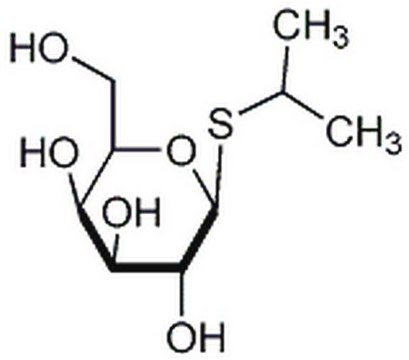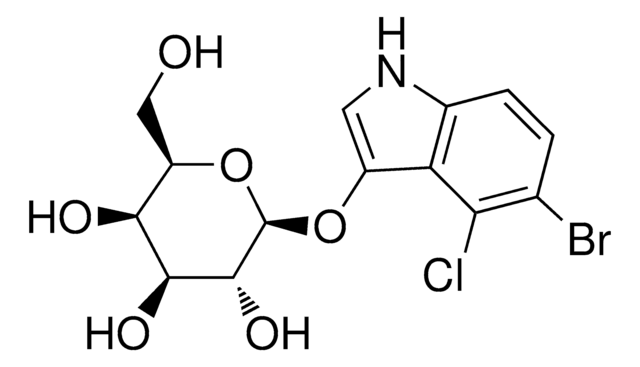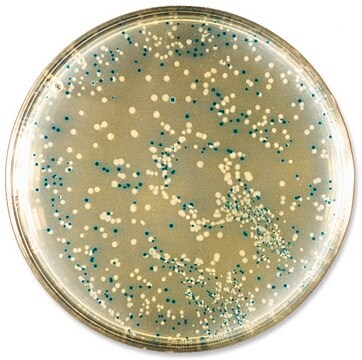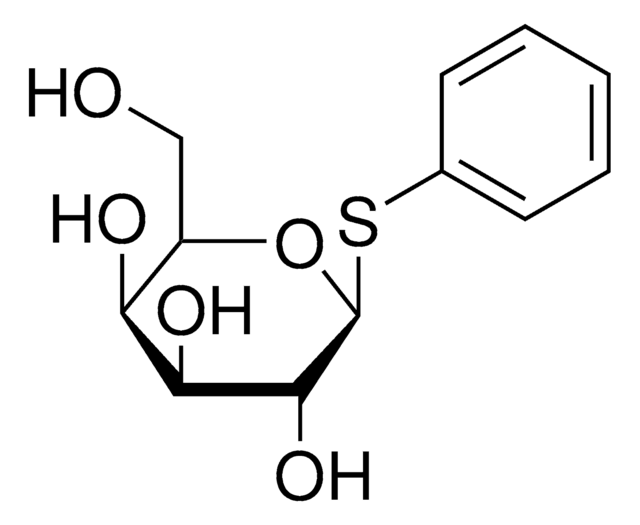I6758
IPTG
≥99% (TLC), ≤0.1% Dioxane
Sinónimos:
Isopropyl β-D-1-thiogalactopyranoside, IPTG, Isopropyl β-D-thiogalactoside
About This Item
Productos recomendados
origen biológico
synthetic
Nivel de calidad
descripción
non-ionic
Análisis
≥99% (TLC)
formulario
powder
técnicas
thin layer chromatography (TLC): suitable
impurezas
≤0.1% Dioxane
color
white to off-white
intervalo de pH útil
5-7 (50 g/L)
mp
105 °C ((221 °F))
solubilidad
water: 0.05 g/L, clear
aplicaciones
cell analysis
life science and biopharma
temp. de almacenamiento
2-8°C
cadena SMILES
CC(C)S[C@@H]1OC(CO)[C@H](O)C(O)[C@H]1O
InChI
1S/C9H18O5S/c1-4(2)15-9-8(13)7(12)6(11)5(3-10)14-9/h4-13H,3H2,1-2H3/t5-,6+,7+,8-,9+/m1/s1
Clave InChI
BPHPUYQFMNQIOC-NXRLNHOXSA-N
¿Está buscando productos similares? Visita Guía de comparación de productos
Descripción general
Aplicación
- in the induction of protein expression in Lactobacillus reuteri GroEL and mutants
- in the induction of protein expression in Escherichia coli
Acciones bioquímicas o fisiológicas
Otras notas
Reconstitución
producto comparable
Palabra de señalización
Danger
Frases de peligro
Consejos de prudencia
Clasificaciones de peligro
Carc. 1B
Código de clase de almacenamiento
6.1C - Combustible acute toxic Cat.3 / toxic compounds or compounds which causing chronic effects
Clase de riesgo para el agua (WGK)
WGK 3
Punto de inflamabilidad (°F)
Not applicable
Punto de inflamabilidad (°C)
Not applicable
Equipo de protección personal
Eyeshields, Gloves, type N95 (US)
Elija entre una de las versiones más recientes:
Certificados de análisis (COA)
¿No ve la versión correcta?
Si necesita una versión concreta, puede buscar un certificado específico por el número de lote.
¿Ya tiene este producto?
Encuentre la documentación para los productos que ha comprado recientemente en la Biblioteca de documentos.
Los clientes también vieron
Artículos
General protocols for growth of competent cells and their transformation (uptake of DNA).
Protocolos
General protocols for growth of competent cells in microbial medium.
Nuestro equipo de científicos tiene experiencia en todas las áreas de investigación: Ciencias de la vida, Ciencia de los materiales, Síntesis química, Cromatografía, Analítica y muchas otras.
Póngase en contacto con el Servicio técnico










